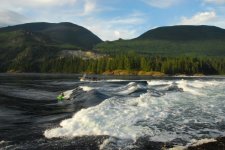Here's a question for you Puget Sounders.... I was visiting Gig Harbor this week (by car only, unfortunately). While crossing the Tacoma Narrows bridge on Monday, I looked down on the north side and the water looked like rapids in a river. It was windy that day and I expected whitecaps, but that water looked like it was boiling. I'm an upper river rat, so I don't know anything about salt water and tides, but I'm pretty sure Puget sound doesn't have any rapids. :?
When I returned home over the bridge two days later, it was as calm as a lake. So, what was I seeing? Does the tide do strange things to the water under the bridge? It was pretty impressive, but I was glad I wasn't down on the water!
When I returned home over the bridge two days later, it was as calm as a lake. So, what was I seeing? Does the tide do strange things to the water under the bridge? It was pretty impressive, but I was glad I wasn't down on the water!

